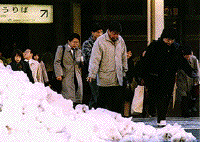 Science & Technology || Search|| Back Numbers WARMER WINTERS FOR TOKYO: Climate Change and Urbanization Raise Temperatures February 27, 1998 
City dwellers deal with fewer freezing days than in the past. (Photo: Kyodo) Tokyo's winters are getting steadily warmer. The annual number of days on which the lowest temperature is below freezing has plummeted, particularly in urban areas: In Tokyo, it is less than 10% of levels 60 years ago. The nationwide rise in temperatures resulting from emissions of greenhouse gases and the "heat island" phenomenon specific to large cities can be cited as the main reasons. But these phenomena may eventually come to affect industrial activity and people's lifestyles. Land of Rising Sunshine Levels According to the Meteorological Agency, the number of days when the Tokyo temperature dropped below 0 degrees centigrade averaged 53 per year in the 10 years from 1931, while the average annual figure for the period 1991-1997 was a mere 3.3 days. Declines were also noted in a comparison of the same periods in the central Honshu hub of Nagoya, where the average fell from 75.6 to 25.3, and in Fukuoka on the southern island of Kyushu, where it plunged from 36 to 2.3. The same phenomenon can be observed away from big cities: The number of below-zero days in Mito, on the northern fringe of the Tokyo metropolitan area, fell from 93 to 71.9, while Katsuura on the eastern fringe saw a drop from 20.8 to 6.7 below-zero days. Although the difference is not as great as in Tokyo, it is still considerable. The number of mornings when there is a nip in the air is decreasing steadily in urban areas. Alongside these milder winters, there has been a striking increase in average annual temperatures. The Meteorological Agency researched the averages over the past 100 years of seven cities with populations of at least 1 million people, including Tokyo, and 15 provincial cities impacted minimally by urbanization. It found that temperatures have risen 1.3 degrees in provincial cities, whereas the jump in big cities came to 2.9 degrees, over twice as much. This winter has followed the pattern. Average temperatures across the
nation in December were at least 1 degree higher than usual. Out of 154
meteorological observatories and monitoring points nationwide, 149 reported
higher annual readings than usual. Average monthly snowfall in December was
also lower more or less nationwide. El Nino is believed to be the cause,
and 1998 seems likely to bring on another mild winter.
Drops in the number of below-zero days in provincial cities are evidently caused by a nationwide rise in temperatures amid the process of global warming. According to the Meteorological Agency, in the case of big cities the process of urbanization has added fuel to the global-warming fire, making the increase in temperatures grow steeper. Since the latter half of the 1970s, the rise in minimum temperatures has slowed, but if the warming effect and urbanization continue apace, temperatures will continue to rise. The rise in temperatures, caused by an increasing concentration of greenhouse gases such as carbon dioxide in the atmosphere, and the accompanying rise in sea levels, are an ongoing process across the world. Drought, inundation, and other weather abnormalities thought to be connected with global warming are deepening their impact on agriculture and forestry. Changes in the global environment are slowly making themselves felt in Japan; it seems likely that they will impinge significantly on industrial activity and everyday life. For this reason, the world is watching what comes of COP3--the Third Session of the Conference of the Parties to the U.N. Framework Convention on Climate Change--held in Kyoto in December.  Edited by Japan Echo Inc. based on domestic
Japanese news sources. Articles presented here are offered for reference
purposes and do not necessarily represent the policy or views of the Japanese
Government. Edited by Japan Echo Inc. based on domestic
Japanese news sources. Articles presented here are offered for reference
purposes and do not necessarily represent the policy or views of the Japanese
Government.
|
